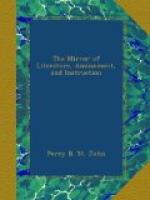Title: The Mirror of Literature, Amusement, and Instruction Volume 10, No. 279, October 20, 1827
Author: Various
Release Date: May 30, 2005 [EBook #15945]
Language: English
Character set encoding: ASCII
*** Start of this project gutenberg EBOOK the mirror of literature ***
Produced by Jonathan Ingram, David Garcia and the
Online
Distributed Proofreading Team.
* * * * *
The mirror of literature, amusement, and instruction.
Vol. X, no. 279.] Saturday, October 20, 1827. [Price 2d.
* * * * *
[Illustration: Brambletye House.]
BRAMBLETYE HOUSE.
On the borders of Ashdown Forest, in the county of Sussex, stands the above picturesque ruin of Brambletye House, whose lettered fame may be dated from the publication of Mr. Smith’s novel of that name, in January, 1826. The ruin has since attracted scores of tourists, as we were, on our recent visit, informed by the occupier of the adjoining farm-house; which circumstance coupled with the high literary success of Mr. Smith’s novel, has induced us to select Brambletye House for the illustration of our present number.
Brambletye, or, as it is termed in Doomsday Book, Brambertie House, after the conquest, became the property of the Earl of Mortain and Cornwall, forming part of the barony then conferred upon him, and subsequently denominated the honour of the eagle. Passing into possession of the Andehams, Saint Clares, and several others, it came into the occupation of the Comptons, towards the beginning of the seventeenth century; and from the arms of that family impaling those of Spencer, still remaining over the principal entrance, with the date 1631 in a lozenge, it is conjectured that the old moated edifice (represented in the annexed vignette) which had hitherto been the residence of the proprietors, was abandoned in the reign of James I., by Sir Henry Compton, who built the extensive and solid baronial mansion, commonly known by the name of Brambletye House.
[Illustration]
“From their undaunted courage and inflexible loyalty to the Stuarts,” says the novelist, “the Comptons had been heavy sufferers, both in purse and person, during the eventful progress of the civil wars. The Earl of Northampton, the head of the family, and nephew to Sir Henry, the presumed builder of Brambletye, had four sons, officers under him, whereof three charged in the field at the battle of Hopton Heath, and the eldest, Lord Compton, was wounded. The Earl himself, refusing to take quarter from the rascally Roundheads, as he indignantly termed them, even when their swords were at his throat, was




